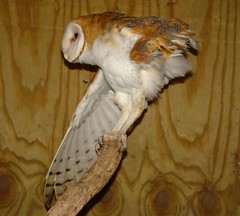( I have seen the date instead as July 3rd, but I am going by a date from the NWF.)
This act was written in a time when people wore hats adorned with egret feathers....and signed documents with pelican quills. If you click on the above link, you will find that it is a bunch of legalese, but the basic premise is to protect over 800 total species (I think that's the number...there have been many additions and subtractions over the years) from intentional harm, killing, taking of eggs, nests, feathers, live birds, etc.
If you are bored and want to count them all, this link will show you the current list of protected birds.
A funny/cruel thing I do to kids during my education programs:
I ask: "Okay. We all know what this is, right? (holding up a feather from one of our birds) Yep, that's a feather. Who's found a feather before? (most of them raise their hands).
Anyone have a nature collection? Like rocks, feathers, moss? In a jar at home? (most of them raise their hands again) Okay. Did you know that you are committing a crime?"
Their. Faces. Are. Priceless.
I explain that the "nature police" is not going to break their doors down for one feather. But I make it clear that, because of the MBTA, no one may possess a single feather from any bird of prey or a bird that migrates. I give them an example of poaching that I heard from David, the former Ed. director at RAPTOR: A few years ago in Canada, wildlife officials found 50 bald eagles, shot and killed, with their heads, tails and feet sawed off. The bodies were dumped into a pile and left to rot. If there is a more saddening or rage-inspiring example of poaching, I haven't heard it yet.
Kids always try to get around it:
"What about turkey feathers?" (not illegal, since they are a game bird)
"What about a sea gull?" (I flummox them by saying that there is no such bird)
I remind them that even ornithologists sometimes have to look up a feather they are examining, in a feather atlas, so someone in the general public would usually have NO idea what kind of feather they were looking at. I also tell them that if they find a feather, by all means they should pick it up (they aren't as dirty as some neurotic moms would like to think), examine it and appreciate it. There's a lot to a feather...more than just prettiness. But then, they must put it back.
Someone always asks: "So why do YOU have feathers and stuffed specimens?" And I talk about the special permits that RAPTOR, Inc. and other centers (such as nature centers, museums, etc)
MUST have to possess them. If you are to do it all right and legal, it's a very complication process that includes listing every single bird you possess, how they are used, who uses them for programs and so on.
Speaking of permits and programs....Tomorrow is a big day. The Barn Owl, affectionately known as "No-No", will be presenting at his FIRST education program! After two months of training on the glove, and Saturday's first try in his carrier (he was PERFECT), he is all ready for the public! I am so thrilled!
By the way, the name "No-No" doesn't resonate well with some at RAPTOR, due to the negative connotation. (Barn owls do that no-no-no move, called toe-dusting, when they feel threatened).
I buy that. But what shall we call him?

Take a bow, little guy. You are about to be very, very popular.

5 comments:
Barney Fife.
I loved that show.
Gosh I'd learn so much sitting in the middle of a bunch of school chidren during one of your programs...
Great post, Susan.
Since barn owls are kind of spooky, call him Casper (the friendly ghost).
That was a great post Susan. I do like the way you explain it to them about what we call artifacts.
What about the peacock feather that we bought a few years ago?
Post a Comment